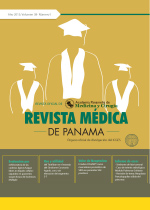Presión positiva en vía aérea y cánula de alto flujo en el tratamiento de insuficiencia respiratoria por COVID-19, en unidades de cuidados respiratorios especiales, de dos hospitales de referencia en la República de Panamá.
Autores/as
DOI:
https://doi.org/10.37980/im.journal.rmdp.20221892Palabras clave:
COVID-19, oxígeno, cánula de alto flujo, ventilación mecánica no invasivaResumen
Introducción: En Panamá, así como en otras partes del mundo como España e Italia, se crearon Unidades de Cuidados Respiratorios Especiales para brindar soporte no invasivo a pacientes con insuficiencia respiratoria por neumonía por SARS-COV-2. En este trabajo se describen las características demográfica y clínicas de los pacientes que utilizaron ventilación no invasiva y/o cánula de alto flujo. Material y métodos: El diseño del estudio fue prospectivo, observacional y descriptivo en dos hospitales de referencia en Panamá. Los pacientes firmaron un consentimiento informado y se procedió a llenar un cuestionario diario sobre las características demográficas y variables clínicas diarias. Resultados: Se logró recolectar datos de 173 paciente, 60.69% correspondió al sexo masculino y se encontraban en una media de edad de 59 años, la comorbilidad más común fue la hipertensión arterial. El 88.75% de los pacientes tuvieron un NEWS 2 por arriba de 5 que indicaba mayor vigilancia por riesgo medio de paciente crítico, tanto la VMNI como el CAF tuvieron buenos resultados, 60% y 80% respectivamente. Conclusión: Nuestro estudio nos da luces sobre las características de los pacientes con insuficiencia respiratoria que requirieron dispositivos no invasivos y nos permite observar la evolución de estos en un contexto donde los recursos son limitados para terapia en cuidados intensivos.
Archivos adicionales
Publicado
Número
Sección
Licencia
Derechos de autor 2022 Infomedic Intl.Derechos autoriales y de reproducibilidad. La Revista Médica de Panama es un ente académico, sin fines de lucro, que forma parte de la Academia Panameña de Medicina y Cirugía. Sus publicaciones son de tipo acceso gratuito de su contenido para uso individual y académico, sin restricción. Los derechos autoriales de cada artículo son retenidos por sus autores. Al Publicar en la Revista, el autor otorga Licencia permanente, exclusiva, e irrevocable a la Sociedad para la edición del manuscrito, y otorga a la empresa editorial, Infomedic International Licencia de uso de distribución, indexación y comercial exclusiva, permanente e irrevocable de su contenido y para la generación de productos y servicios derivados del mismo. En caso que el autor obtenga la licencia CC BY, el artículo y sus derivados son de libre acceso y distribución.






